Convalescent smallpox, infectious diseases. Later, general
The smallpox epidemic which began in 1881 placed a great strain on hospitals in London. To relieve pressure on available beds on its hospital ships moored at Long Reach, the Metropolitan Asylums Board (MAB) established a tented camp for convalescent smallpox patients at the back of one of its other institutions, the Darenth School for Imbecile Children, which had almost been completed but was still unoccupied.
Transferred from the smallpox ships four miles away, the first patients arrived in May to their tented accommodation. The Asylum provided kitchen and other facilities but by the autumn the weather became too cold and the patients were moved indoors to the Asylum buildings.
In 1883 MAB purchased Gore Farm from a Mr Morton at the cost of £16,000. The 160 acre farm was located immediately to the south of the Asylum. An additional strip of land linking the farm to the roadway was bought for £125 from the Ecclesiastical Commissioners. In 1884 the temporary camp at Darenth Park transferred to the site. It consisted of 15 double tents (one tent inside another for weather protection) which could accommodate 300 patients, two marquees which were for the patients to use during the day (one for females and one for males) and ancillary tents for staff, stores, toilets, etc. More tents were added as more patients arrived. Two wooden huts were built, which later became infirmaries. Part of the Hospital grounds were cultivated, the land being fertilized by locally produced sewage.
Most patients remained at the camp for three weeks. Visitors were not allowed unless death was imminent, in which case a visit was permitted following suitable precautions. Patients were encouraged to write letters, which were disinfected before being posted.
During the 1884-1885 epidemic all smallpox patients were treated initially on the hospital ships at Long Reach, with recovering patients being sent to Gore Farm; the smallpox hospitals in London became fever hospitals.
By 1886 MAB was being pressured to improve consitions for patients at the farm. Despite being advised that wooden huts were a fire hazard, difficult to ventilate, heat and clean, eight temporary huts made from wood and iron were built in 1887 on the southern part of the farm. Each hut had 26 beds. A house for the Medical Superintendent was built to the southeast of the huts and an administration block and laundry to the north of them. This became the Gore Farm Lower Hospital. Many more huts were added later to the north.
In 1890 permanent buildings were erected on the higher ground at the northeast of the farm. They comprised 20 two-storey ward blocks and 3 small isolation wards and a two-storey administration block with a kitchen and laundry to its rear. On each side of the kitchen block was a two-storey block for staff accommodation - the men on the east and the women on the west. A Nurses' Home was built on one side of the boiler room and a block for domestic staff on the other, both three-storeys high. A two-storey temporary hut was built for night nurses. This site was known as the Gore Farm Upper Hospital; it had 1000 beds.
At the time of the next smallpox epidemic the Upper Hospital was full of scarlet fever patients, so the Lower Hospital was extended to 850 beds. Twelve dormitories were built and the two recreation halls converted to wards of 40 beds each. The building workers were obliged to remain on the site and were not allowed to visit Dartford because of the risk of spreading infection. Four policemen also resided on site to maintain law and order.
By 1903 the last of the 'River Hospitals', Joyce Green Hospital, opened and MAB decided that there were sufficient smallpox beds; Gore Farm would be used instead to provide treatment for convalescing fever and general patients from London. In 1908 it was renamed the Southern Convalescent Hospital; in 1911 it became simply the Southern Hospital.
During WW1 the Lower Southern Hospital became the Dartford War Hospital with 1,200 beds, treating badly wounded German soldiers, many of whom died and were buried at Darenth Park (later 285 graves were exhumed by the German War Graves Commission and reburied at Cannock Chase). Those who recovered were sent to a nearby Prisoner-of-War camp and were employed doing menial jobs and helping out on local farms. In 1918 German POWs were sent to Joyce Green Hospital to help prepare accommodation for over 1000 Eastern European refugees suspected of having smallpox.
In 1918 the U.S. government took over the Upper Hospital for its sick and wounded servicemen and it became the United States Base Hospital No. 37. It was the largest American military hospital in England. The brick buildings were supplemented by wooden huts. The 20 ward structures each contained 100 beds, giving the Hospital some 2,000 beds. The army medical unit consisted of about 50 surgeons, 100 nurses and 200 enlisted men, most from the King's County Hospital in Brooklyn, New York. In October King George V and Queen Mary paid a visit to the Base Hospital, chatting to the wounded soldiers, whose experience of meeting royalty was limited. In the two hours spent there, the King had spoken to 83 soldiers from 22 different States.
When news of the Armistice was announced on 11th November, the German patients in the Dartford War Hospital and the Americans in the Base Hospital celebrated the moment together.
The Base Hospital closed at the end of the year and, in 1919, the American servicemen returned to the U.S. Some 4,437 American soldiers had been treated during its operational lifetime, of whom 40 had died, mainly of pneumonia. The largest convoy received had been of 202 men, followed immediately by the second largest, of 160 influenza cases from an incoming transport (25 of whom died).
(In 1955 the Hospital Veterans returned and presented a plaque to the Hospital, commemorating their stay. The plaque is currently stored at the Dartford Museum).
After the war the Southern Hospital was used for infectious diseases and for poor children from London in need of convalescence.
By 1921 the Upper Hospital had 922 beds and the Lower 610. By 1924 bed numbers had greatly reduced to 600 at the Upper site and 160 at the Lower.
In 1930 the LCC took over control of the Hospital; at this time the Upper Hospital had 777 beds and the Lower 767 and was used mainly for rehabilitation of infectious disease patients.
In 1938 the Royal Naval Hospital at Chatham was transferred to the Southern Hospital during the Munich crisis, along with some 300 naval personnel. At the outbreak of WW2 it became a Group 1 Emergency Medical Service Hospital, expected to deal with a large number of casualties. The Hospital facilities were upgraded and it became one of the largest general hospitals in England, with 1580 beds. It received more casualties from Dunkirk than any other hospital and, throughout the war, received civilian air-raid casualties from London.
After WW2 most of the original huts built in 1887 for the Lower Hospital were demolished (the remaining buildings later became the Mabledon Hospital).
In 1948 the Southern Hospital joined the NHS. It remained a general hospital until it closed in 1959, deemed too big and not suitable for modernization. Patients and staff were transferred to Joyce Green Hospital.
Present status (October 2008)
In 1967 the Hospital buildings were demolished. The Dartford by-pass - the A2 - was built through the site. The remainder of the land is now part of Darenth Country Park.
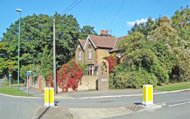
The entrance to the Darenth Country Park off Gore Road.
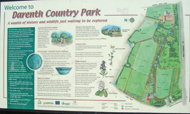
The history guide panel for Darenth Country Park mentions the Darenth Park and Southern Hospitals.
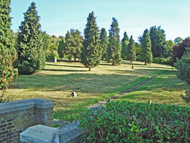
Southern Rest, the cemetery for the Southern Hospital.
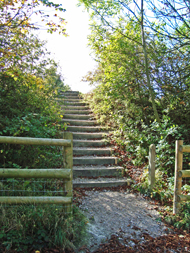
Steps up to wasteland from Cemetery Road.
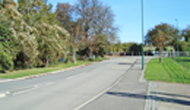
Looking along the entry drive from Gore Road.
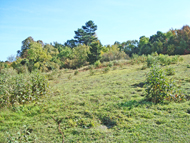
Wastelands on the ridge of the Southern Hospital site.
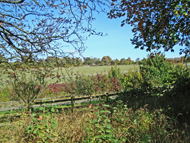
Looking towards the Darenth Park Hospital site from near Southern Rest.
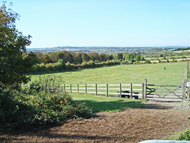
The path down from the Darenth Park Hospital site.
The case was heard in London in November. The residents referred to in the injunction were Mr Fleet's tenants. One of them, a groom, stated that he had seen Hospital employees drinking in a local pub. Other witnesses claimed that the smallpox virus could travel air-borne for one mile, and also burial of the dead was hazardous.
Scientific witnesses were also heard and the judgment was given in favour of the Metropolitan Asylums Board in the grounds that no case of smallpox had been found among the inmates of the Asylum, who lived much nearer to the camp.
Dock LL, Pickett SE, Noyes CD, Clement FF, Fox EG, Van Meter AR 1922 History of American Red Cross Nursing. New York, Macmillan.
Fife GB 1920 The Passing Legions: How the American Red Cross met the American Army in Great Britain, the Gateway to France. New York, Macmillan.
http://members.aol.com/wizzz900/page26.html (Accessed June 2009)
www.aim25.ac.uk
www.dartford.gov.uk
www.dartfordarchive.org.uk
www.dartfordhospitalhistories.org.uk
www.nhshistory.net
www.portcities.org.uk
www.workhouses.org
Return to home page